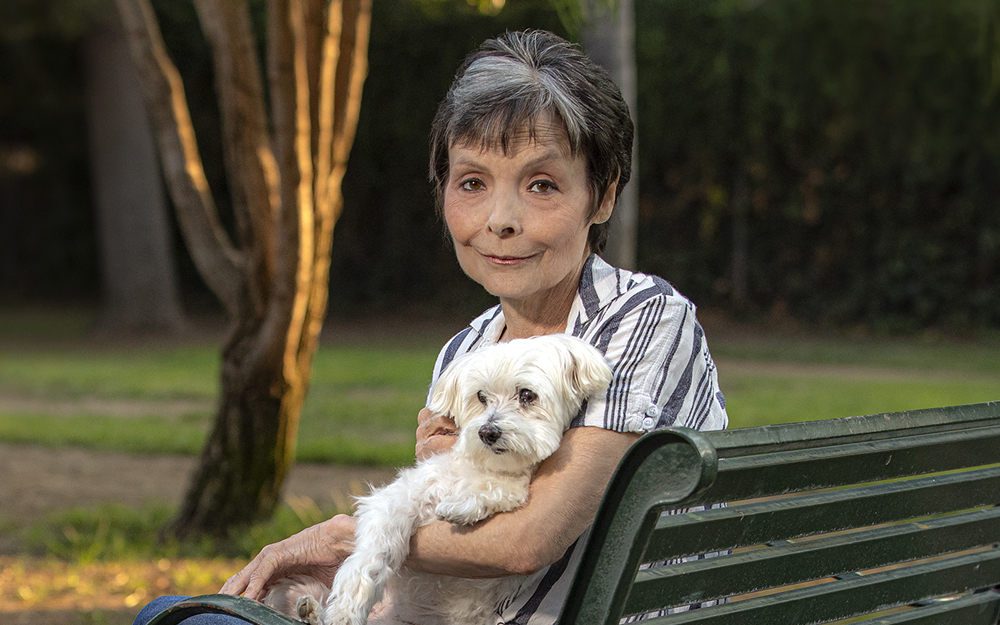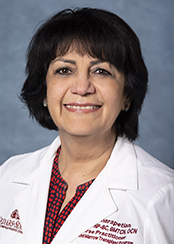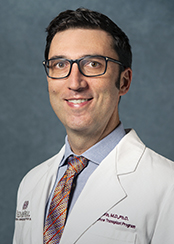Cedars-Sinai Blog
The Long Path to Bone Marrow Transplantation
Sep 23, 2021 Cedars-Sinai Staff

Not much can intimidate Cathy Griffin. Her job is to interview celebrities—the kind who might leave the average person starstruck are just the people she talks to at work.
She's quick with a question and a follow-up question, and perhaps a few more follow-up questions after that.
When she was diagnosed with leukemia in 2018, she leaned into many of these same reporting skills to get her through it. Those skills alone weren't enough.
"Really ask questions, trust your doctors and nurses, but realize they're human, too," says Cathy, 62, remembering her long journey to a cancer-free life. "I can't say relax because I didn't relax much. Ask for help. Learn as much as you can and have faith."
"Really ask questions, trust your doctors and nurses, but realize they're human, too. I can't say relax because I didn't relax much. Ask for help. Learn as much as you can and have faith."
Cathy hadn't been admitted to a hospital in 20 years, but she started feeling fatigue and shortness of breath. She initially blamed her symptoms on the heat, but she realized her condition was more serious when she couldn't get more than a couple steps into her walks with her Maltese dog, Marcel.
She went to see her doctor, who ordered chest X-rays, but by the very next day, even talking on the phone was too difficult.
"I looked at my dog and said, 'I'm going to the ER at Cedars-Sinai to see if they can figure out what this is,'" she says.
She was promptly admitted into the ICU, where she was treated for fluid on her heart and lungs.
She was ultimately diagnosed with leukemia that required immediate treatment.
"If I didn't get chemo immediately, I would only have four months to live," she says. "Four months!"
Cathy found a good friend to care for Marcel and prepared for treatment.
A strong community of support
Cathy's treatment required her to receive chemotherapy infusions as an inpatient. She rallied support, chatting with a small group of friends on a video chat. She bonded with a nurse who shared her faith and prayed with her over one of her first bags of chemotherapy treatment.
"She hoped that I would get all the positives from that chemo bag and none of the negatives," Cathy says. "It was so beautiful."
Chemotherapy, which successfully addressed her cancer, took a toll on Cathy's body. The effort of a trip from her bed to the bathroom was simply too difficult some days, and she would call on friends or neighbors to help her. At one point, her weight dropped to 84 pounds.
Cathy says asking for and accepting help for these everyday basic needs was very difficult. At the same time, she is effusive about the generosity of the friends, family and care team members who helped her through this very difficult phase of her treatment.
One dear friend took Marcel in, fostering him most of the time for nearly three years, with frequent visits to lift Cathy's spirits. Her brother Kenneth Cathy, who lives in Texas, was her spiritual mentor.
"He was in the boat with me every day," she says.
Many friends came to her aid when she was unable to work and needed help supporting herself while she couldn't work.
Cathy grew close to her treatment team. She knows her nursing team by name, readily talking about the roles Sandra Rome, a clinical nurse specialist, and Seda Gharapetian, a nurse practitioner, played in her care and the training of other nurses in the cancer program. She got to know the chaplaincy and volunteers who offered her support and comfort.

Seda M. Gharapetian, NP
While working toward remission with chemotherapy, Cathy was also seeing members of the bone marrow transplant team.
Transplant is often recommended for people who have blood cancers once they've achieved remission, as it has the potential to wipe out the cause of the cancer and greatly reduces the risk of the cancer returning. Bone marrow transplants are essentially two transplants in one, says Dr. Noah Merin, hematologist-oncologist in the Cedars-Sinai Blood and Marrow Transplantation Program. Patients are transfused with stem cells that will produce blood as well as immune cells from a donor.
Cathy wasn't ready to consider a transplant. She was concerned about finding a caretaker to help her through the 90 days following the transplant when she would require significant help. She was nervous about being unable to work again and the risks of getting a transplant.
She decided it was not time.
Turning toward transplant
For months after her remission, Cathy resisted the idea of a transplant, even as her prognosis worsened.
"I was taking a long time to come to terms with my disease," she says. "Dr. Merin was so patient with me, and I'm sure I taxed his patience. I can be a challenging patient, but they led me through it."
In fall 2019, while she was at church, she was praying about her cancer and came to a clear decision.
"I heard God's voice that He would get me through my transplant, and everything would work out," she says. "From there, I never waffled."
A friend from North Carolina, Karen Frankola, offered to come stay with Cathy and take care of her in preparation of her transplant and in those first crucial months following it.
"She would take me to my appointments twice a week, and though she felt that caregiving was 'out of her wheelhouse,' she did a brilliant job," Cathy says. "It would have been impossible for me to do this without her."
The path to transplant isn't a simple one, Dr. Merin says. Transplant is often seen as a last resort, he says, but it's a far more effective treatment when it's deployed while a patient is healthy and strong, newly free of their cancer. Understandable fears about graft vs. host disease and other complications make some people reluctant to consider it.

Noah M. Merin, MD, PhD
Once Cathy was ready, Dr. Merin formulated a carefully balanced plan. The goal is to achieve a stable remission, but the therapies that can induce that remission can take a toll on the organs and body.
"Cathy had all the risk factors we're concerned about in a transplant—older age, she'd had a relapse and we needed to get her back into remission," Dr. Merin says. "She's also an excellent example showing that we can transplant people who have higher risk factors. We can extend the benefit of transplant to people at higher risk if we can make the process safer."
To make the process safer, he put her on a chemo medication more commonly used in children that is a much lower dose than an adult would typically get. The team also uses radiation therapy at a reduced intensity. One of the benefits of radiation, Dr. Merin says, is it's predictable. Unlike chemotherapy, there are no variables based on a patient's size or organ function or metabolism.
"We also have better tools than we've ever had before to measure exactly how much cancer someone has, so we knew very precisely about what percentage of her bone marrow was leukemia," he says.
In Discoveries: The Weapon Inside
Even the reduced treatment took a toll, Cathy says. She was using a wheelchair most of the time on the treatment. She strongly wanted to skip the last chemotherapy treatment scheduled before her bone marrow transplant, a highly toxic drug called asparaginase, which was being given at one-sixth of the standard dose.
Dr. Merin met her at the infusion center to discuss her options.
"I felt it was really important for her to take this last dose because she still had detectable, low-level leukemia in her bone marrow and her transplant was about four weeks away," he says. "Without that last cycle, her leukemia would be increased when she went into the transplant, which reduces the chance of being cured. But I told her I'm not the chemo police and it was her decision. I think that meant a lot to her."
It did.
"When he gave me that control as a patient, it was a smart thing to do," she says. "I looked at him and decided I would do it. I had gone from saying, 'I'd never have a transplant,' to saying, 'Please, please, give me this transplant.' I was ready."
Even at the greatly reduced dosage, the chemotherapy worked effectively, Dr. Merin says.
It took nearly a year from her deciding to accept a transplant to her anonymous donor giving cells in July 2020.
"We spent an entire year improving my remission. I learned by asking questions about how they were making transplants safer and more accessible. They're not cookie cutter. I respect my doctors, but I don't have trouble asking them questions, and I never met a Cedars-Sinai doctor or nurse who didn't answer my questions as fully as possible."
Life after transplant
In July 2018, Cathy was diagnosed. In July 2020, she received her transplant, an infusion of cells from an anonymous 30-something donor. In July 2021, she celebrated the anniversary of her transplant with no detectable cancer cells in her body.
"I'm not only alive, but I'm thriving," she says.
She has learned lots of lessons from her time as a transplant patient.
"We spent an entire year improving my remission," she says. "I learned by asking questions about how they were making transplants safer and more accessible. They're not cookie cutter. I respect my doctors, but I don't have trouble asking them questions, and I never met a Cedars-Sinai doctor or nurse who didn't answer my questions as fully as possible."
She reflects often on her anonymous donor, the support of her brother and her friends—who rallied around her from near and far—the important role her faith played in her healing and her Cedars-Sinai care team.
As an author and journalist, Cathy is used to constructing narratives out of the details of a life. When she looks at the details of her own journey, two themes resound throughout it: faith and gratitude.
"The miracles just kept coming," she says. "I know how blessed I am that I got this donor, this perfect match. I prayed for strength, for my doctors and that it would all work out. I'm so grateful for all the friends who helped me, for my donor, for my brother and for my care team."



